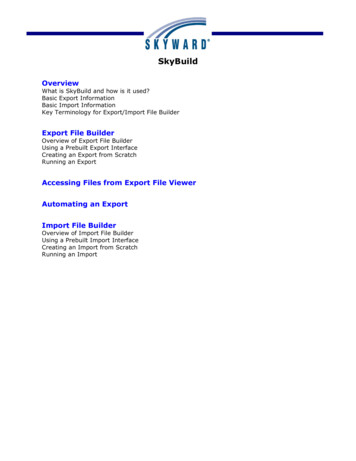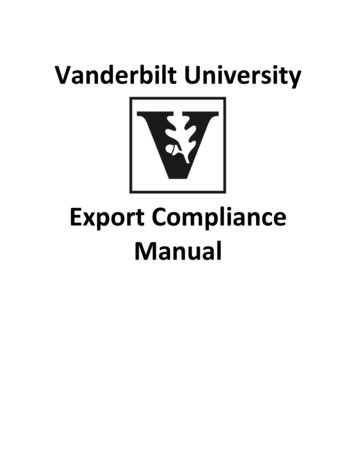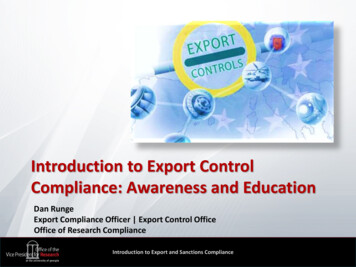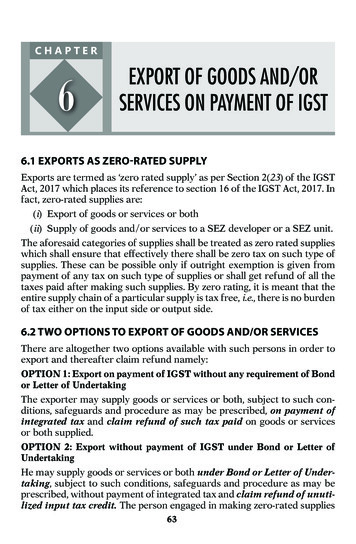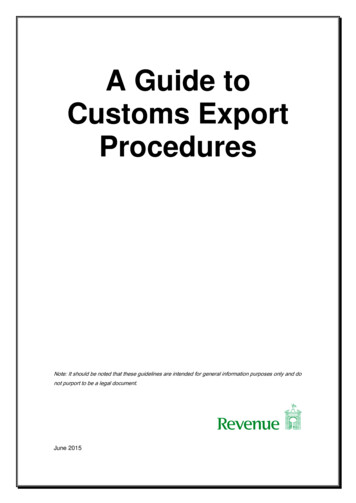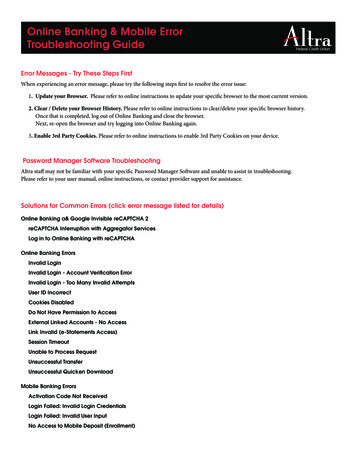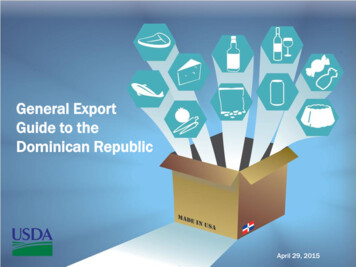
Transcription
General ExportGuide to theDominican RepublicApril 29, 2015
DisclaimerMay 15, 2015This document was produced for the United States Department of Agriculture/Foreign AgricultureService (USDA/FAS) in Santo Domingo, Dominican Republic by the law firm Headrick, Rizik, Álvarez &Fernández, (http://www.hrafdom.com) under the Emerging Markets Project (EMP)/DR ImportRequirements for Food & Agricultural Products.The author’s views in this publication do not necessarily reflect the views of the USDA/FAS SantoDomingo office.
ContactPlease do not hesitate to contact the offices below with questions or comments regarding this study orto request assistance.The US Embassy in Santo DomingoOffice of Agricultural Affairs (OAA-USDA/FAS)Attn: Mr. Luis C. González B.Tel: (809) 567-7775; Ext. 7683E-mail: gonzalezlx@state.govAvenida República de Colombia # 57, Altos de Arroyo HondoSanto Domingo, D.N. 10605
Project PurposeThe present project aims to catalogue all administrative procedures and legal requirementsto export food products to the Dominican Republic, including: Identification of legal and administrative requirements involved in each step from door-to-doorexport process to Dominican Republic. Estimates of governmental fees related to the fulfillment of each request. Indication of standard documents generated during the export process. Highlight of existing differences in procedures/time/cost between the legal (theoretical) andpractical course of actions throughout the import process.
Methodology Data based on a survey and research conducted in conjunction with third party to capture standardexport procedures for food products. Companies surveyed are distributors/retailers, domestically owned of limited liability. Government agencies considered are those involved in whichever stage of the import process forfood products, including policy makers. The study includes all necessary documents, permits, licenses, authorizations and notificationsrequired by Dominican authorities. Procedures are considered only when interface with a third party (government or non-government)is made necessary. Each procedure is separated by its nature. Time is calculated in calendar days. The calculation is made from the moment it is initiated andlasts until it is completed. Costs measure fees, taxes, tariffs, services of third parties required to complete the clearanceprocess.
Dominican AgenciesThe Ministry of Agriculture and the Ministry of Public Health and Social Assistance are the primarygovernment regulators of food and beverages. Their jurisdiction follows:Ministry of AgricultureMinistry of Public Health and SocialAssistanceConsumer-oriented productsConsumer-oriented productsFood: Animal origin products (red meats and by-products,poultry meat and by-products, fish, seafood products, dairyproducts and eggs) Plant origin products (fruits and by-products, vegetablesand by-products)Food: All pre-packaged (processed)Departments Department of Agricultural and Livestock Promotion Department of Animal Health Department of Plant Protection General Directorate of LivestockDepartmentsGeneral Directorate of Drugs, Foods and Sanitary Products(DIGEMAPS)Beverages: Mineral water, flavored waters, energyhydroelectrolitic beverages and soy beveragesdrinks,
Case Studies Fresh Fruits and Vegetables Tree Nuts Poultry Wine and Beer Pork Prepared Foods Cheese Condiments Yogurt Sauces Breakfast Cereal Snack Foods
eCostProcedureNumber ofDocuments Process Initiator Inquiries Trademark RegistrationTechnical Form (when applicable)Marketing Authorization ApprovalPhytosanitary and Zoosanitary GuidanceLetters and AuthorizationsCertificate of OriginProduct LabelingPro-Forma InvoiceTariff Quotas and Concessions ProcessesEMBARKATION9. Bill of Lading or Airway Bill10. Import DeclarationIMPORT CLEARANCE11. Inspection Request to Quarantine Officeat Port of Entry / Quarantine Controls (whenapplicable)12. Import Taxes13. Standard Documents14. Customs’ Valuation15. Product Release
PRE-EMBARKATION1.Trademark BARKATIONTechnical Form (when applicable)3.IMPORT CLEARANCEMarketing Authorization Approval4.Phytosanitary and Zoosanitary GuidanceLettersNational Office of Industrial Property (ONAPI, per its Spanish acronym)One original version and one hard copy of the letter addressed to the Director of the Department of Distinctive Signs,requesting the registration of the trademark in question and indicating the following information: applicant’s name andaddress; mercantile registry number and national taxpayer number (in case of a Dominican applicant); goods and/orservices to be protected pursuant to the International Nice Classification of Goods and Services; and printed versionsof the trademark’s design (when applicable).The application process begins with the filing of the trademark application.If the mark is approved in the substantive evaluation stage, publication fees must be paid.Afterwards, the trademark is published in the Official Gazette of the ONAPI.As from said publication date, third parties have 45 days to file for opposition against the application.If no third party contests the application within this period, the registration certificate is issued which is renewable forsubsequent periods of ten (10) years each.Process InitiatorTimeframeGovernmental feesInquiriesIt should be carried out by the owner of the trademark or by the distributor if the latter has a Power of Attorney forthese matters.Approximately 3 to 4 months.Depends on whether the trademark in question is a word or a design application and/or amount of classes requested.A word application under one international class amounts to RD 5,735.00. These expenses do not include attorney’sfees.National Office of Industrial Property (ONAPI)Av. Los Prόceres No. 11Santo Domingo, National District, Dominican RepublicTel.: (809) 567-7474Fax: (809) 732-7758E-mail: servicioalcliente@onapi.gob.doHome Page: http://www.onapi.gob.do
PRE-EMBARKATION1.Trademark Registration2.EMBARKATIONTechnical Form (when applicable)3.IMPORT CLEARANCEMarketing Authorization Approval4.Phytosanitary and Zoosanitary GuidanceLettersThe technical form is a document generally required only for the first import of agriculturalproducts. Once said product has been imported, the technical form may no longer berequired.
PRE-EMBARKATION1.Trademark Technical Form (when applicable)3.IMPORT CLEARANCEMarketing Authorization Approval4.Phytosanitary and Zoosanitary GuidanceLettersMinistry of Public Health and Social Assistance (MISPAS, per its Spanish acronym)One original version and one hard copy of the letter addressed to the Minister of Health and Social Assistance of the DominicanRepublic, requesting the marketing authorization approval of the product, indicating: name and address of the applicant; name of the product; type of product and trademark; name or company name of the manufacturer; country of origin and address of the manufacturer; qualitative and quantitative product formulas; list of ingredients; description of the product’s manufacturing process; characteristics of the product’s container or package.Accompanied by: three original samples of the product, in the same presentation (package or container) in which it will be sold in the market (incase of liquids, each sample must contain a minimum of 250mL; in case of solids, each sample must contain a minimum of 250gr); copy of the Trademark Registration Certificate granted by the National Office of Industrial Property (ONAPI); copy of the importer’s Industrial Registry Certificate granted by the Development Center and Industrial Competitiveness(PROINDUSTRIA); Free-Sale Certificate issued by the exporting country, duly legalized under the Hague Convention (“Apostille”); copy of the importer’s Mercantile Registry Certificate; and, copy of the importer’s Sanitary License (granted by the Ministry of Public Health and Social Assistance); authorization granted in favor of the legal representative of the product in the country, duly legalized under the Hague Convention(“Apostille”).Labeling must comply with the format established in the norm NORDOM 53 (3rd Revision), regarding the Labeling for Pre-PackagedFoods.All ingredients contained in pre-packaged foods and beverage items should meet the requirements specified in Decree 528-01,regarding the Rules for the Control of Risks in Food and Beverages.
PRE-EMBARKATION1.Trademark RegistrationProcedure2.EMBARKATIONTechnical Form (when applicable)3.IMPORT CLEARANCEMarketing Authorization Approval4.Phytosanitary and Zoosanitary GuidanceLettersThe application process begins with the filing of the application.Afterwards, the samples provided along with the application are sent by the Ministry of Public Health and SocialAssistance to the National Laboratory “Dr. Defilló” or to another authorized laboratory by the Ministry, to run a healthanalysis on the product, namely: “Instituto de Innovación en Biotecnología e Industria (IIBI)” and the “LaboratorioAgroempresarial Dominicano (LAD).” Once the analysis and the application are approved, the Ministry issues aMarketing Authorization Certificate with a registration number. The authorization can be renewed every five (5) yearsand can be renewed indefinitely.Process InitiatorTimeframeGovernmental feesGenerally, it is carried out by the legal representative/local distributor of the product in the country, but can also bedone by the manufacturer. For such purposes, the foreign manufacturer has to appoint a local distributor before theapplication is submitted to the Ministry of Public Health and Social Assistance.Approximately 3 months, however, it may take longer because there is no timeframe established by law.Amount to a total of RD 4,000.00. This payment must be separated.A certified check must be made in the name of “Dirección General de Salud Ambiental” for the sum of RD 1,600.00and another one must be made in the name of “Ministerio de Salud Pública y Asistencia Social” for the sum ofRD 2,400.00.These expenses do not include attorney’s fees.InquiriesMinistry of Public Health and Social Assistance (MISPAS)C/ Héctor Homero Cruz esq. TiradentesEnsanche La FeSanto Domingo, National District, Dominican RepublicTel.: (809) 541-3121E-mail: correo@salud.gob.doHome Page: http://www.sespas.gov.do
PRE-EMBARKATION1.Trademark Technical Form (when applicable)3.IMPORT CLEARANCEMarketing Authorization Approval4.Phytosanitary and Zoosanitary GuidanceLettersMinistry of AgricultureFruits and Vegetables:-Application is made through a form (“Formulario de Solicitud Guía de No Objeción Fitosanitaria”) which must becompleted and filed before the Department of Plant Protection, with the following information: name of theimporter; address; telephone and fax numbers; goods to be imported; quantity; unit of measurement; port oforigin; port of departure; port of entry; use; and transportation.-In addition, a written request must be addressed to the Division of Plant Quarantine accompanied by the invoiceor pro-forma invoice, certificate of origin, and Phytosanitary or Zoosanitary Certificate issued by the exportingcountry.For Animals products and by-products:-Application is made through a written letter (one original and three hard copies) filed before the GeneralDirectorate of Livestock, indicating the following information: name of the importer; address; telephone and faxnumbers; goods to be imported; quantity; unit of measurement; country of origin and country of export, port oforigin; port of departure; port of entry; use; transportation; value of the goods, animal species with which theproduct is made. This application must be accompanied by the commercial invoice or pro forma invoice.Once the shipment arrives to the Dominican Republic, it shall be accompanied by the original InternationalSanitary Certificate (in Spanish) and the original Certificate of Origin.
PRE-EMBARKATION1.Trademark RegistrationProcedure2.EMBARKATIONTechnical Form (when applicable)3.IMPORT CLEARANCEMarketing Authorization Approval4.Phytosanitary and Zoosanitary GuidanceLettersPrior to loading any shipment, the local importer must request an authorization for the importation of goods.If there are phytosanitary o zoosanitary requirements, a Phytosanitary or Zoosanitary Guidance Letter is issued by theDepartment of Plant Protection or the General Directorate of Livestock, respectively, with the requirements for theimportation. (If there are no requirements, the request is sent to the Unit of Pest Risk Analysis. The Unit of Pest RiskAnalysis will issue its recommendation, when applicable.)After the Guidance Letter is issued, the Department of Agricultural and Livestock Promotion will issue theauthorization.Important NotesThe goods must have an expiration date and should not be close to its expiration date (maximum 6 months ofduration).The animals from which the products come from, are natives from the exporting country or have remained for at least90 days prior to slaughter and/or export.In the case of meat products, the exporting country must also certify that: (i) the meat comes from a slaughterhousewith an address and veterinarian authorization number, and in the case of meat cuts, the same conditions arerequired; (ii) meats and packs must have bear stamps that certify that they come from animals slaughtered inslaughterhouses authorized by official veterinarian services; (iii) meats have been recognized as suitable for humanconsumption; (iv) meats have been butchered in an authorized facility for cutting and with inspections of officialveterinarian services.The timeframe for issuance of these guides is subject to significant variance and administrative discretion. It is notunusual for one to be issued in 48 hours, but it is also not unusual for one to take several months to be issued.Process InitiatorThe US exporter must work with the local importer in order to obtain said authorizations.
PRE-EMBARKATION1.Trademark RegistrationTimeframe2.EMBARKATIONTechnical Form (when applicable)3.IMPORT CLEARANCEMarketing Authorization Approval4.Phytosanitary and Zoosanitary GuidanceLettersThe Phytosanitary and Zoosanitary Guidance Letters may take up to two to three days, so long as no level of risk isinvolved in the importation of the goods in question.The permit issued by the Department of Agricultural and Livestock Promotion may take an additional two to three daysas well.Governmental feesIn order to obtain the Guidance Letter before the Department of Plant Protection, government fees amount toRD 200.00. These expenses do not include legal fees.In order to obtain the Guidance Letter before the Department of Animal Health, government fees amount toRD 2,000.00. These expenses do not include legal fees.After this phase is completed, the Department of Promotion for Agriculture and Livestock will then issue thePhytosanitary authorization for a cost of RD 2,000.00 (for dairy products, fruits, vegetables and tree nuts),RD 3,000.00 (for meat products) and RD 5,000.00 (for pork).InquiriesMinistry of AgricultureAutopista Duarte Km. 6½Jardines del NorteSanto Domingo, National District, Dominican RepublicTel.: (809) 547-3888 / (809)547-1692E-mail: info@agricultura.gob.doHome Page: http://www.agricultura.gob.do
PRE-EMBARKATION5. Certificate of Origin6. LabelingEMBARKATION7. Invoice or Pro Forma InvoiceIMPORT CLEARANCE8. Tariff Quotas and Concessions ProcessesA certificate of origin is an international trade document attesting that goods in a particular exportshipment are wholly obtained, produced, manufactured or processed in a particular country. In thiscase, the certificate of origin should be issued by the United States.
PRE-EMBARKATION5. Certificate of Origin6. LabelingEMBARKATIONIMPORT CLEARANCE7. Invoice or Pro-Forma Invoice8. Tariff Quotas and Concessions ProcessesLegislation requires the following information on the product’s packaging materials: name of the product; list of ingredients; net weight; manufacturer and importer’s name and address; the importer’s industrial registry number (granted by PROINDUSTRIA); marketing authorization number (granted by the Ministry of Public Health and Social Assistance); country of origin; batch identification number; manufacturing date; expiration date; instructions for conservation of the product; and, instructions for use.The text must be in Spanish language; it must be legible and intelligible for consumers. For products whose label isnot in the Spanish language, an adhesive sticker can be used on the original label, containing all of the requiredinformation.In addition, in case of alcohol, the label should have a disclaimer that reads: “El consumo de alcohol perjudica lasalud” (the consumption of alcohol damages the user’s health).The US exporter should forward a sample of the package to the importer to facilitate label development.
PRE-EMBARKATION5. Certificate of Origin6. LabelingEMBARKATION7. Invoice or Pro-Forma InvoiceIMPORT CLEARANCE8. Tariff Quotas and Concessions ProcessesBefore shipment, an invoice or pro forma invoice must be sent to the Dominican importer given that thisdocument is used for obtaining the Guidance Letters and authorizations before the Ministry of Agricultureand initiates the import clearance process.Upon arrival of the goods, the importer must have received the original invoice since it will be used to clearthe goods and for payment of tariffs, duties and taxes.
PRE-EMBARKATION5. Certificate of OriginEMBARKATION6. Labeling7. Invoice or Pro-Forma InvoiceIMPORT CLEARANCE8. Tariff Quotas and Concessions ProcessesCurrently, they are two different and separate processes to request tariff quotas in the Dominican Republic: Allocation of Tariff Quotas granted to the United States of America, under DR-CAFTA; and Tariff Quotas to products listed in the Technical Rectification of List XXIII made by the Dominican Republic before the WorldTrade Organization (WTO) (regulated agricultural products).Tariff QuotaAllocations underDR-CAFTAGovernmentAgencyTariff QuotaApplication andDocumentsAny individual or legal entity, residing in the Dominican Republic, may request the allocation of tariff quotas, withthe exception of industry associations or nongovernmental organizations, of the tariff concessions granted to theUnited States.Office of Agricultural Trade Agreements (OTCA, per its Spanish acronym) Written application to participate in the allocation process of tariff quotas, with the following documents: In case of Individuals: copy of identification card; copy of the National Taxpayer Registry as an individual; description of individual's economic activity; certification issued by the General Director of Customs, which guarantees the import history of the goodsrequested; information on physical infrastructure (i.e., copy of deed or lease, including additional photos of physicalspace); current safety certificate or marketing authorization approval, issued by the General Directorate of Drugs,Foods and Sanitary Products (DIGEMAPS) of the Ministry of Health and Social Assistance, certifying thesafety conditions for handling the goods requested; and, designated address, phone, mobile and fax for notifications.
PRE-EMBARKATION5. Certificate of OriginTariff QuotaApplication andDocumentsEMBARKATION6. Labeling IMPORT CLEARANCE7. Invoice or Pro-Forma Invoice8. Tariff Quotas and Concessions ProcessesIn case of Legal Entities: copy of National Taxpayer Registry number; copy of the Mercantile Registry Certificate issued by the competent Chamber of Commerce and Production; certification issued by the General Directorate of Customs, guaranteeing the import history of the goodsrequested; copy of the last General Assembly of Shareholders, duly registered by the competent Chamber ofCommerce and Production; designation of the legal representative of the company, duly notarized and legalized by the AttorneyGeneral of the Dominican Republic; copy of the identity card of the legal representative of the company; information on infrastructure, (i.e., copy of deed or lease, including additional photos of physical space); current safety certificate or marketing authorization approval, issued by the General Directorate of Drugs,Food and Sanitary Products (DIGEMAPS) of the Ministry of Public Health and Social Assistance), certifyingthe safety conditions for handling the goods requested; and, designated address, phone, mobile and fax for notifications.
PRE-EMBARKATION5. Certificate of OriginAllocationProcessEMBARKATION6. Labeling7. Invoice or Pro-Forma InvoiceIMPORT CLEARANCE8. Tariff Quotas and Concessions Processes The Commission (integrated by the Minister of Industry and Commerce, the Director of the Customs’ House and theMinister of Agriculture) publishes in at least one national newspaper and on the websites of the Ministry ofAgriculture (www.agricultura.gob.do) and the Office of Agricultural Trade Agreements (www.otcasea.gob.do), theinformation on Tariff Quotas available for the next calendar year, no later than October 1st of each year. The deadline for submitting Tariff Quota applications will be fifteen (15) business days after the date of publicationof the Notice of Availability. The allocation of the volumes of tariff quotas will be based on: historical record of the total imports of agricultural goods carried out by the interested party during the pastthree (3) consecutive calendar years, preceding the calendar year in which the tariff quota is available; the quantities requested by the interested parties, provided they are commercially viable; and, the quantities available for Traditional Importers and New Importers, in the corresponding calendar year. The tariff quotas shall be allocated as follows: (a) eighty percent (80%) to Traditional Importers and (b) twentypercent (20%) to New Importers. After the allocation has been granted and published in a national newspaper by the Commission, the importer mustobtain a Phytosanitary Guidance Letter, prepared by the Department of Plant Protection or a Zoosanitary GuidanceLetter, prepared by the Department of Animal Health of the General Directorate of Livestock. The aforementionedprocess is done so by inter-agency cooperation. In other words, the importer does not have to go through theprocess of obtaining the Phytosanitary nor the Zoosanitary Guidance Letters. The Guidance Letters are thendelivered to the Department of Agriculture and Livestock Promotion along with the commercial or pro forma invoice,for issuance of the authorization.
PRE-EMBARKATION5. Certificate of OriginEMBARKATION6. LabelingIMPORT CLEARANCE7. Invoice or Pro-Forma Invoice8. Tariff Quotas and Concessions ProcessesImport authorization process for regulated agricultural products and by-products of plant andanimal origin, protected by the Technical Rectification of List XXIII made by the DominicanRepublic before the World Trade OrganizationUnder the provisions of Article XXVIII of the General Agreement on Tariffs and Trade (GATT) of 1994, the DominicanRepublic made a Technical Rectification of its List XXIII of Tariff Concessions for eight (8) agricultural products. Inparticular: garlic, rice, sugar, chicken meat, onions, beans, powdered milk and corn.The Assigned Quotas to the Products of the Technical Rectification are as follows:ProductsRiceGarlicSugar: Refined/ BrownChicken MeatOnionBeansMilkCornProducts of the Technical RectificationHeadingsVolumeBasic TariffandT.M.%SubheadingsNon-QuotaTariff 0207.10, 0207.21and 0207.410703.100713.31, 0713.32and 0713.330402.10, 0402.21and 61,091,000Does Not ApplyDoes Not Apply
PRE-EMBARKATION5. Certificate of Origin6. LabelingEMBARKATION7. Invoice or Pro-Forma InvoiceIMPORT CLEARANCE8. Tariff Quotas and Concessions ProcessesImport authorization process for regulated agricultural products and by-products of plant andanimal origin, protected by the Technical Rectification of List XXIII made by the DominicanRepublic before the World Trade Organization The Commission for Agricultural Imports (integrated by the Minister of Industry and Commerce, the Director of theCustoms’ House and the Minister of Agriculture) publishes an Annual Calendar for the Import of Tariff Quotas of theproducts listed in its Technical Rectification. These products are placed for public auction organized by the Exchange Agribusiness of the Dominican Republic(BARD, per its Spanish acronym). The Commission and the BARD publish, in a national newspaper, the calendar forthe import of the tariff quotas and organize the public auction on the set date. After those products have been awarded, the BARD issues an auction certification to be used before the GeneralDirectorate of Customs, for the import clearance. Additional quantities can be placed for auction in a calendar year. After the tariff quotas have been assigned, the importer must obtain a Phytosanitary Guidance Letter or a ZoosanitaryGuidance Letter. The Guidance Letter is then delivered to the Department of Agriculture and Livestock Promotion along with thecommercial or pro forma invoice, for issuance of the authorization. Depending on the product and if it is pre-packaged, when applicable, the importer must obtain a marketingauthorization approval.
PRE-EMBARKATION9. Bill of Lading or Airway BillEMBARKATIONIMPORT CLEARANCE10. Import DeclarationShipping instructions advise all the details of the cargo and exporter’s requirements for its physical movement. Itcontains the information related to the sale and the merchandise’s conditions upon embarkation, such as the quantityof product, form of payment, transport temperature, packaging, pallet used, among others.In the Dominican Republic, depending on the product in question, several conditions must be met: The ship’s containers must be cleaned and disinfected before placing the products for shipping. Imported fruits and vegetables must be free of plague or symptoms of diseases, and must not have soil, sawdust orforeign matters, with the exception of mosses, previously disinfected, for its packaging. All wood packaging must comply with the International Standard for Phytosanitary Measures (ISPM) No. 15, to reducethe risk of introduction and spread of forest pests and diseases. Fruits and vegetables should not be packaged or covered in jute bags. Fresh fruits must arrive in refrigerated containers, with temperatures between 0 C (32 F) and 2.20 C (36 F).
PRE-EMBARKATION9. Bill of Lading or Airway BillEMBARKATIONIMPORT CLEARANCE10. Import DeclarationThe importer must prepare the Import Declaration through the Automated System for Customs Management (SIGA, perits Spanish acronym). Nonetheless, only companies can present the Import Declaration through the SIGA. Individualsmust file directly before the General Directorate of Customs.The process for the importation is initiated when the shipping company presents the import cargo manifest. The ImportDeclaration is presented electronically through the SIGA and the following information must be provided: goods to beimported, quantity, description, value, tariff code, weight, and must contain attached scanned copies of the documentsrelated to the importation.The following documentation must be scanned: commercial invoice; bill of lading or airway bill; marketing authorization certificate; phyto-sanitary or zoosanitary Guidance Letters and authorization; certificate of origin; custom agent’s ID card; auction certificate issued by the BARD (for products included in the Technical Rectification), among other documents.The governmental authority reserves the right to require additional documentation. These will be required in original uponarrival of the goods along with the bill of lading or the airway bill.To declare the goods through SIGA, the Single Customs Declaration Form (DUA, per its Spanish acronym) must becompleted. Both the importer and the customs agent have the authorization in a Token previously supplied by theGeneral Directorate of Customs (DGA, per its Spanish acronym). The Token is an electronic device able to access theDGA’s database for the details related to the import declaration in question.Importers have ten days counting from the date of arrival of the goods to present the Import Declaration. Failure to do sowill result in sanctions for late declaration.
PRE-EMBARKATION11. Inspection Request to QuarantineOffice at Port of Entry / QuarantineControls (when applicable)12. Import TaxesEMBARKATION13. Standard DocumentsIMPORT CLEARANCE14. Customs’ Evaluation15. Product releaseAfter the import declaration process has been carried out, the consignee can request the physicalinspection, under the governmental authority’s discretion, of the goods through the SIGA. This is donealong with the customs inspectors and the supplementary control staff, which may include personnel fromthe Ministry of Agriculture, through the Divisions of Plant and Animal Protection, and the Ministry of PublicHealth and Social Assistance, among other competent authorities.Depending on the products in question, an inspection is made by the inspector of the quarantine office ofthe port of entry whom will verify the documentation and perform a physical inspection of the shipment inorder to search for possible plagues and to take samples for its remittance to the diagnostics laboratory.(If the pest is common, the goods could be released with a treatment, depending on the level ofinfestation. If the pest is of quarantine concern, the goods may be returned to its place of origin,confiscated or incinerated.)Once the physical inspection has been verified with the declaration and the origina
to export food products to the Dominican Republic, including: Identification of legal and administrative requirements involved in each step from door-to-door export process to Dominican Republic. Estimates of governmental fees related to the fulfillment of each request. Indication of standard documents generated during the export process.


